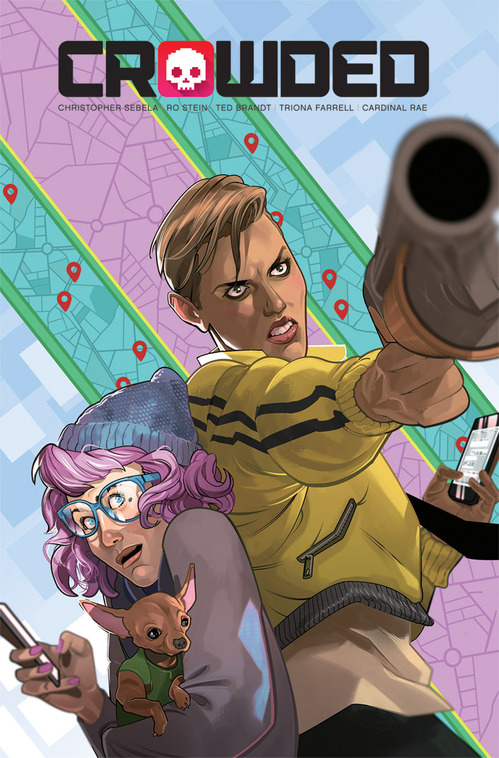The Crowded Creative Team Breaks Down the Gig Economy, Social Media & Style
Christopher Sebela, Ro Stein & Ted Brandt Discuss Their New Image Comics Series
Main Art by Ro Stein, Ted Brandt & Triona Farrell Comics Features Image Comics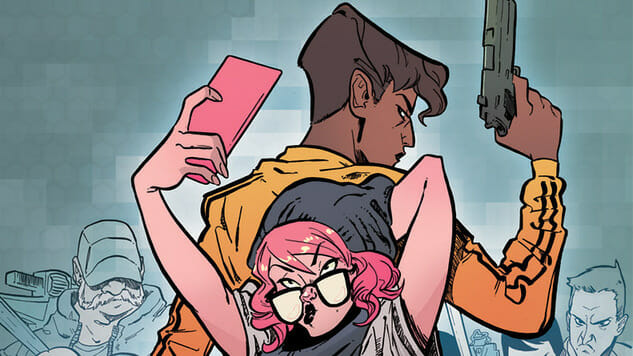
Summaries and solicits of the first issue of Crowded, due out this Wednesday, fall short of really conveying exactly what the book is all about. It’s not uncommon for high concepts to take the lead in marketing, but in Crowded’s case, the book runs the risk of fair but inaccurate comparisons to other stories. The central conceit is that in the near future, we’ll all be able to use an app to put bounties out on ordinary, everyday people who have done us wrong. Legality of crowdsourcing assassinations online notwithstanding, there have been a number of stories that explore the ethical and moral implications of this kind of thing; Black Mirror comes to mind immediately.
What sets Crowded apart from the first page on is that it’s funny and bright both visually and narratively. The pacing is lively and quick, more buddy-cop comedy than dramatic moralizing. Technology isn’t presented as inherently evil or something to be feared, but as a fact of life that can get twisted by ill-intentioned people. The cast is flawed and sympathetic—important when one of the main characters has done something to warrant a bounty—and the repeated attempts at murder act more as backdrop and plot device than a trigger for debate. Thanks in no small part to Triona Farrell’s colors, the world and people drawn by Ro Stein and Ted Brandt are vivid and familiar enough to feel like a real possibility in the next few years. There’s an elastic flexibility to some of the action-packed panels that make them even more kinetic. Between big facial expressions and bold fashion choices, the first issue gives readers a crash course in understanding Charlie, whose life is in danger, and Vita, the guard she hires to protect her from random citizen assassins. Chris Sebela’s dialog is tight and punchy without feeling fake or stiff, and he lets the art do the work in the right places.
In advance of the first issue, Paste exchanged emails with Sebela, Stein and Brandt to discuss the gig economy, avoiding anti-technology bias and designing Crowded’s lead duo.
![]()
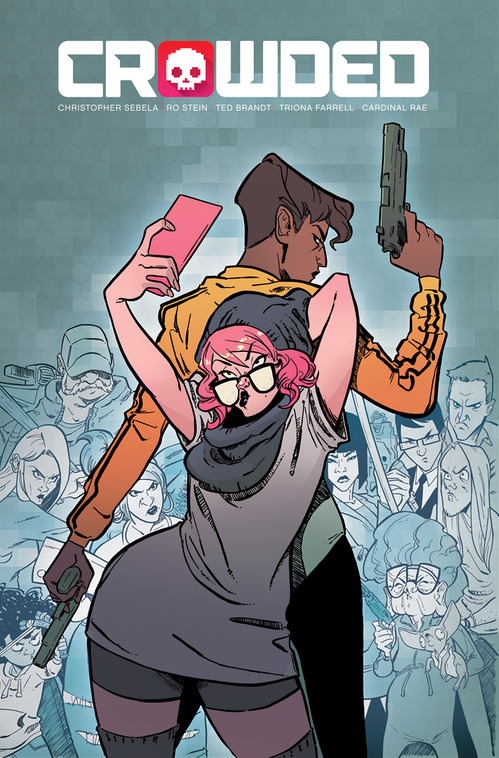
Crowded #1 Cover Art by Ro Stein, Ted Brandt & Triona Farrell
Paste: At the heart of Crowded, it mostly seems to be about the internet and human nature; we see people rating others ruthlessly and using social media to put out hits on each other. What made you want to tackle that kind of story?
Chris Sebela: Mostly it was the hook of the idea I couldn’t shake. I had the whole idea of crowdfunded assassinations but I had no idea what to do with it. I’d tried to pitch it based on the hook alone and an editor, rightfully, told me there was no [story] there. Just from a, “Hey this is a cool idea, I want to get there first” perspective, I was driven. But once I finally managed to build a real story out of it and figure out who Charlie and Vita were, then it became that I just wanted to follow them and find out what happened to them. I feel dumb saying it, but the idea that our book is relevant or has something to say is an accident for me. I never intend this stuff consciously, just the more I thought about things, the more all these pieces seemed to logically fit together like this. I mostly try to write what feels right to me and, ideally, my thoughts make it through in a way that makes sense or is open to interpretation enough that it works on a deeper level than just a fun comic.
Ro Stein: When Chris first described the concept of the concept of the book, there were two ways it could go. We could either take it really seriously, or the other way, that is instinctual to both Ted and I, which is a route with madcap adventure. As soon as Chris started describing Charlie and Vita, Ted and I turned to each other and went, “Oh, this is gonna be a buddy comedy,” which is a genre we enjoy and hadn’t yet tackled.
Ted Brandt: Yeah, that’s it in a nutshell. For us the appeal of Crowded as a project didn’t lie in its timeliness, or as a potential critique of online culture. Sure, it’s definitely possible to see all of that in there, but as Chris said, that’s largely a byproduct. We weren’t attracted to the book because of those aspects, because they’re just the set. What really spoke to us were the characters of Charlie and Vita, and the incredible potential their interactions can have.
Paste: Do you remember the first time you saw some of the darker parts of how people treat one another online?
Sebela: So my first internet account was on Prodigy. I’ve been on the internet for a while now. Which makes it hard to really pinpoint, but I’d have to say that I was part of this IRC channel called #skate (I’ve never successfully skateboarded in my life, but I had a friend who did and he roped me into checking it out) that was very cliqueish and brutal to newcomers or people they didn’t like. And luckily I was accepted as one of the cool kids, mostly, so I got to either witness it or join in gleefully. It was a whole Lord of the Flies situation with a bunch of proto-nerds. It was a lot like what the internet is today. I guess I was lucky that I saw it at an age where the appeal of that was sort of wearing off and I didn’t pick up the mantle. There’s a universe where I went the wrong way and am a very awful troll and I shudder to picture that timeline.
Stein: Honestly, I don’t. It’s been going on long enough that it’s all blurred together. It’s also a part of the internet age that I’d rather not focus on in my own time. Yes, there are plenty of people out there using the internet to be shitty and to do hurtful—sometimes to the point of life-endangering—things, but there’s also a lot more people who use the same technology to bring joy to people. They help them, entertain them, make friends and so many other things. I’d rather focus on the good than the bad.
Brandt: Yeah, this one is a struggle for me. I have a pretty heavily curated online existence, just to try to keep myself relatively level, so I learned about things like doxxing rather later than a lot of folks, for example. I have no clue when I first encountered a proto version of anything serious; the worst I remember in my earlier internet days was some mildly cliquey behaviors in some forums I was on, but it was a small group of us and we just muttered in private messages rather than engaging in anything publicly. Oh, I guess on the Whitechapel forums there was a public white supremacist, long before that was cool online, but he was chased out pretty quickly, so I guess at the time I didn’t see it as a significant event.
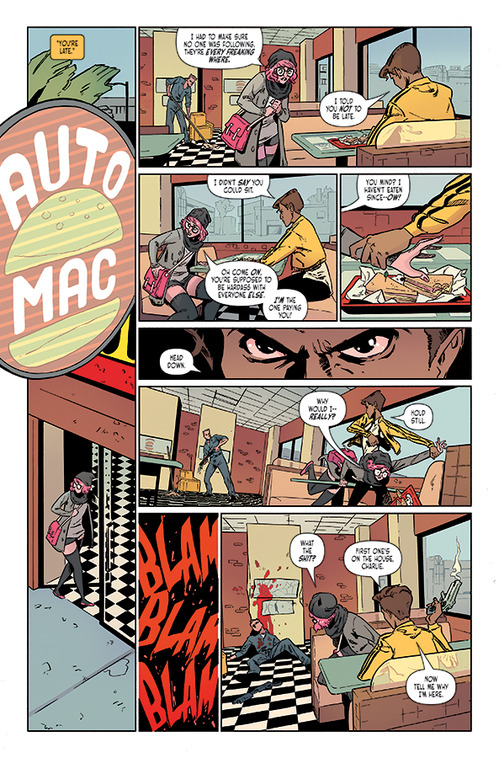
Crowded #1 Interior Art by Ro Stein, Ted Brandt & Triona Farrell
Paste: One of the things that really seems to set Crowded apart from other explorations of social media is that there doesn’t seem to be an implication that technology is inherently bad or scary. Both the characters’ behavior and the visuals pretty accurately portray just how integrated technology has become in our lives without demonizing it. Was that always part of the goal?
Sebela: I don’t know if it was a goal, it’s just something I believe in and I guess it shines through. I love technology, I love the internet for the most part. You can put the greatest tools in the world out there and some folks are gonna find a way to make it do the worst thing possible, just to see if it can be done. It’s always about people and that’s, I guess, what I was mostly interested in. How these things show up as almost-miracles and then we watch them get debased down to the level of a bag of shit being set on fire on someone’s front stoop. I find that human impulse fascinating and when I got the idea for Reapr, it felt like a natural progression and something I wanted to chase to see where it would lead. Who’d take part in something like that? Probably a lot more people than anyone would be comfortable with.
Stein: I think so; I mean, technology doesn’t have a moral stance, that’s down to the users. As I said before, they’re the ones who use it for good or bad. It never occurred to me to put a moral stance onto the technology; our story is about people. The particular people this story is focusing on, as far as we know at this point, do not use these systems to be damaging to those around them. Technology is just a tool for how they live their lives. Now if we were focusing more on the people trying to kill Charlie, maybe the technology would be portrayed in a more negative stance. For me, it’s a case of perspective, and as far this particular story goes, the perspective is pretty neutral as far as the whole integrated technology thing goes.
Brandt: I always think that we’re building a world to feel real, but the story that it backdrops is the important bit. Sure, the story is technology-based, but we could make a very similar story in much earlier times about a woman falsely accused of being a witch, and her defender. The technology isn’t the story, it’s the people who are abusing it and twisting it into something dangerous.
Paste: Crowded has great on-page portrayals of characters using apps and texting to communicate, allowing readers to peek in on what they’re doing without feeling forced or distracted. What was the process in designing those interactions?
Sebela: I didn’t want the apps to overwhelm stuff. It’s very easy to fall down that rabbit hole, so we try to do it sparingly, have a lot of it feel natural. I think especially with texting, so many of us do that in the middle of conversations we’re having that that kind of casual multitasking felt right.
Stein: Some of the design of app usage comes from the fact that even when the apps are in use, it’s the character interacting with them that is the story, so I always tried to keep the focus firmly on the human angle, with the app stuff overlaid on the panel. I’d seen it done that way in a few TV shows and films and I thought it was a pretty cool way of doing it.
Brandt: As far as a lot of the texting goes, that was all handled by our excellent letterer, Cardinal Rae. They handled the texting really nicely, allowing it to feel like a totally natural part of the storytelling.
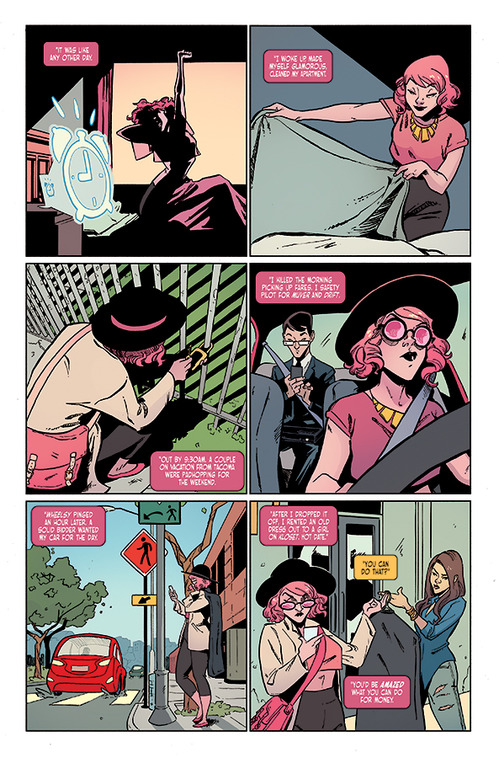
Crowded #1 Interior Art by Ro Stein, Ted Brandt & Triona Farrell
Paste: Not only does Crowded seem to stray away from the rote “being a luddite is safer” attitude, there’s also some exploration of what the gig economy has done to folks. Even though it’s linked to the social media boom, most stories like this one don’t tackle that sort of thing. What made you want to include it?
Sebela: The gig economy stuff wasn’t initially part of it. But the more I thought about a world where Reapr would even exist, it made sense that the Internet of Jobs that we’re currently living through would only get bigger in a world like that. Weirdly, I didn’t have to do a lot of speculation about what would be possible, since every job I list in Charlie’s day-in-the-life sequence is stuff you can go out there and get paid to do right now. I think it also appealed to me because I’ve been freelancing for over 10 years and so my whole life has been a form of this constant hustle since I started, forever looking for new things to plug the gaps and get paid, even if you don’t have time in your life for it. And even these days I’ve contemplated doing a few shifts for stuff like Postmates or something like that, because it’s such a weird concept to pick up and put down a job like that.
Stein: It’s funny because I am something of a luddite! I’m still not 100% on how to use Skype. I think the app gig economy is something of a double-edged sword. It’s pretty cool that these kind of jobs are possible but it also kind of sucks that the job market is so shoddy and unstable that people need to be able to juggle things in such a way. I imagine having to wear so many different hats would be one heck of a strain and incredibly stressful!
Brandt: I was definitely interested in exploring the gig economy aspect, even a little. Stable employment is falling, and more and more people are having to do multiple piecework jobs to stay afloat. I fully support that, but only if that is what the worker actually wants. Chris is right that that sort of life is very similar to freelancing, but at least we signed up for it!
Paste: Charlie and Vita, the main characters, are both women, which comes with some different assumptions and preconceived notions that readers might have. Was that the case from the get go, or did their character designs change as the story developed?
Sebela: It was always Charlie and Vita. Mostly it’s because I’m just not interested in writing about dudes and putting more dudes out into the world. I have to live with myself all the time and it’s exhausting. When I’m writing, I want to have it be work, I want it to challenge me. Writing characters whose eyes I haven’t been looking through all my life keeps me from slipping into autopilot and keeps me on my toes. And I want to challenge those preconceived notions that readers might have. I want them to fall in love with Charlie and Vita but also make some faces at some of the stuff they do. I don’t want them to be perfect, I want them as screwed up and flawed as all the people I know. And ultimately, I’m writing the kind of book I gravitate towards as a reader and the kind of book I think comics could stand to have more of.
Stein: When designing Charlie and Vita we kind of wanted to play into assumptions on some level, maybe not the ones you’re talking about, but ones that are frequently employed to build characters in animation. From the get go Vita was designed to look pretty serious. Rigid and quite sharp. She is the wall protecting Charlie from everything trying to kill her. She was also designed first and was pretty easy to nail down. Ted immediately had an idea in his head for what she should look like and it was just…right. Charlie took a bit longer to figure out. She was designed to be a visual counterpoint to Vita, both for visual interest and to display their contrasting personalities. She’s made of soft curves and flowing movements. She is at heart a very adaptable character by her own necessity. She does have some sharper elements in her design, though, as she’s not a complete softy.
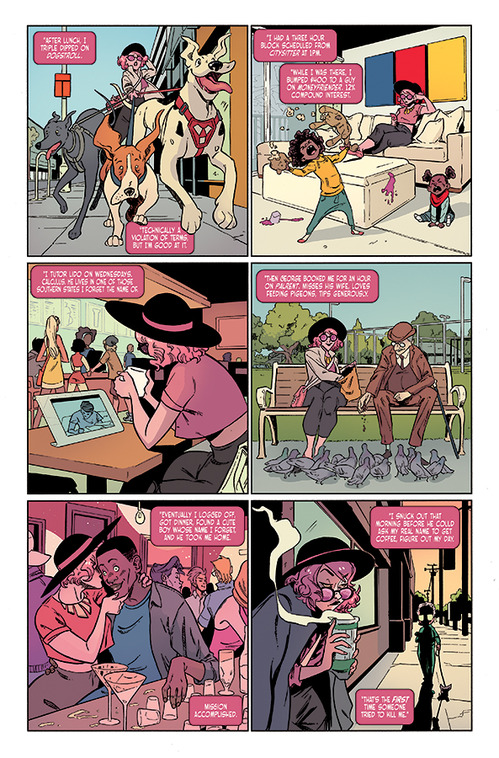
Crowded #1 Interior Art by Ro Stein, Ted Brandt & Triona Farrell
Paste: It’s really easy to villainize women who appear to be too invested in social media, particularly feminine women like Charlie. Given that she’s the one with the bounty on her head, she could’ve become unsympathetic quickly. What did you do to combat that?
Sebela: I’m a dude who’s too invested in social media, so there’s no way I could’ve written a book clucking my tongue at someone else who is too. I think that was the easiest way to counter it, I wrote what I know. The only reason I don’t post more selfies is I’m pretty sure no one wants to see it. I sure don’t, most times. I just wrote Charlie as a human being. Sure, she might be a little too online, she definitely has some big issues, she can be annoying as hell, but these snapshots don’t make up all of who she is or make her someone worth dismissing (or killing) because of it.
Stein: Ted and I are artists who live in a small town in the middle of the English countryside—to us social media is where all the people are! Certainly, at least, the people who would share our most prominent interests. I think people who would villainize a woman for using social media too much either don’t use it themselves and so don’t understand it, or do use it and haven’t taken the time to step back and realize that they aren’t so different from the people they’re criticizing.
Brandt: For myself, I’m glad it worked out this way; not only would I be extremely hypocritical to judge someone for being extremely online, but not bringing over every problem from the real world into the story makes for some small upsides to the dystopia we’re building for the book.
Paste: Charlie in particular seems to be really tapped into trends and though Vita is more isolated from life online, she’s got a pretty unique sense of style too; what kind of statement do you think their fashion choices make? How did you go about bringing them to life?
Sebela: For my part, I just did long write-ups on both Charlie and Vita where I give a biography of them. Where they came from, their families, what they like, what they hate, tidbits and interesting info. Stuff I think makes them who they are and I just sent that to Ro and Ted without much in the way of physical descriptions. It’s the ideal collaboration process for me and it worked out pretty perfect.
Stein: Ted came up with Vita’s look—and it was definitely her Look as she’s that kind of person—so I’ll leave him to talk about that. I was kind of in charge of Charlie, and her outfits were based on a combination of looking at fashion blogs and Pinterest and just winging it a bit with my own sensibilities. Whether that’s a good combination or not remains to be seen as I’m hardly the most fashionable of people! But everyone on the team seems to like how I’m dressing her so I can’t be doing too badly.
Brandt: Vita was super easy, for reasons it’s difficult to pin down. Just as soon as Chris gave us her background, I knew what she looked like. I did a basic sketch, which Ro turned into an actual character sheet, and I sorted out the colors. Without getting too much into it for the sake of spoilers, Vita’s clothing choices are a reflection of where she is in life: trapped between her past and her attempts to escape it, trapped between her natural formal/withdrawn nature and trying to fit into the world. She’s a character of tension, and so the clothes needed to convey that whilst still looking like something a human would wear.
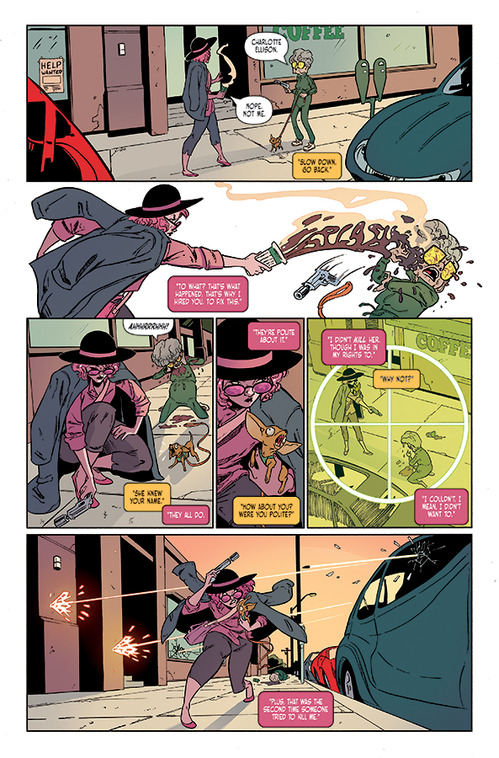
Crowded #1 Interior Art by Ro Stein, Ted Brandt & Triona Farrell

Crowded #1 Interior Art by Ro Stein, Ted Brandt & Triona Farrell
